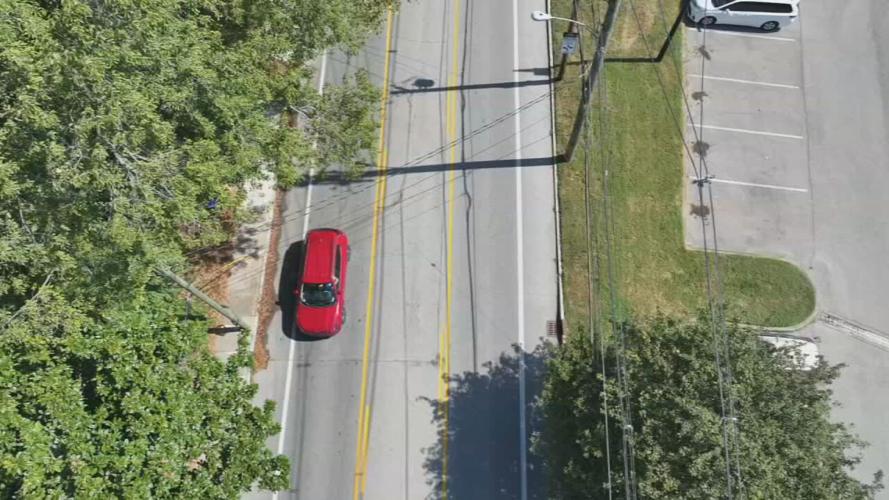LOUISVILLE, Ky. (WDRB) -- There has been an overall decline in crashes on Louisville roads reworked for safety reasons over more than a decade, a new report has found.
The report from the Kentucky Transportation Center analyzed city- and state-managed "lane diets," road alterations and other measures since 2009, noting that total crashes, speed-related crashes and pedestrian collisions all fell in places with at least a year of before-and-after data.
"The study findings suggest that roadway reconfiguration is an effective safety countermeasure that merits continued use in Louisville," the authors, University of Kentucky engineers William Staats and Adam Kirk, wrote.

A section of Grinstead Drive near Interstate 64 that has been reconfigured to reduce travel lanes (WDRB photo)
Roadway reconfiguration, also known as road diets or rightsizing, typically involves converting a four-lane road to a three-lane road with a turn lane in the middle.
Metro government has had "complete streets" policies in place since the late 2000s that include such changes. Advocates have long argued that slimmed down streets help calm traffic, making roads safer for drivers, walkers and other users.
One of those advocates is Chris Glasser, president of Streets for People. It's a Louisville nonprofit dedicated to making the city's roads safer. Friday, Glasser he wasn't surprised that the report pointed to positive results of the changes.
"Not to be glib about it, but my sort of response is like, 'Yeah, duh,'" Glasser said Friday. "I think a lot of advocates and design advocates have been saying for a long time this is a really important part to making streets safer for everybody."
But revamping streets to reduce travel lanes has irked some business owners, drivers and residents. The latest example has been parents complaining of long car lines after dismissal at Jefferson County Public Schools.
In all, the study shows, city and state traffic engineers have converted or proposed changes to 60 sections of streets in Louisville, completing 40 of those. Those projects often involve reducing lanes, providing marked bicycle areas and adding central turning lanes.
"I think (the research) confirmed what we've been advocating for for the better part of a decade, in that these reconfigurations are great for safety for all road users," Glasser said.
Researchers looked at 33 roads with at least one year of crash data before and after the work was done. Those include the most recent projects on Taylor Boulevard and Winkler Avenue, and an area of Lexington Road between Interstate 64 and Frankfort Avenue.
The study found the overall number of crashes of all types fell by 690 since the road changes, while speed-related crashes also fell by 51. However, there was no change in the number of bicycle crashes.
There also was a slight increase — three — in fatal and severe-injury pedestrian crashes, but there was an overall decrease in pedestrian collisions.
The trends were similar for 22 projects with five years of data, with no change in bike crashes but overall drops in total wrecks, speed crashes and pedestrian collisions.
The study looked at 16 projects that went from four-lane roads to smaller configurations. While all crashes dropped, bike crashes of almost all types actually increased, even though 11 projects included bike lanes or other such infrastructure.
"Dedicated bicycle facilities provide a safer space for cyclists, but the addition of these facilities also may attract more users, which in turn increases cyclist exposure to vehicles, and potentially bicycle crashes," the researchers wrote.
They noted an overall increase in crashes on 12 roads that were two lanes before their work. Most were streets with one-way traffic, however, most of those crashes didn't involve injuries or resulted in property damage only. Those projects — 11 of which have bicycle lanes — also had decreases in bike crashes, the authors noted.
While Glasser said road diets are a good first step, he'd like to see even more work done to calm traffic.
"I think there's just like a next step or two that we need to get to as a city," he said.
The study did not provide specific crash data for individual streets. And there wasn't enough data to evaluate newer projects, such as a section of New La Grange Road near Lyndon and parts of Bardstown Road and Baxter Avenue.
Metro Public Works was not available for an interview Friday.
Related Stories:
- Louisville councilman makes push for automated speed cameras along residential city streets
- Louisville leaders launch online survey in latest push to make city's roads safer
- KYTC to review dangerous corridor that has seen deadly crashes, including teenager
- New study ranks the 53 most dangerous stretches of roadway in Louisville
Copyright 2024 WDRB Media. All Rights Reserved.














